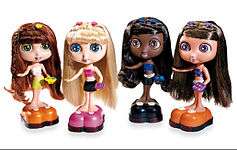Diva Starz
 | |
| Type | Doll |
|---|---|
| Company | Mattel |
| Country | United States |
| Availability | 2000–2004 |
| Slogan |
'We know what's up! (2000-2001) We know what's stylin'! (2002-2004) |
| Official website | |

Diva Starz was a series of fashion dolls created by Mattel Inc. during the Christmas shopping season of 2000.[1] They are similar in design to the MGA Entertainment Bratz dolls released in 2001, and the Flavas dolls released by Mattel in 2003. Four dolls (Alexa, Tia, Summer, and Nikki) were offered in the original debut.[2] The line discontinued in 2004.
History
Each doll is approximately 11 inches (28 cm) tall, with plastic clothing and combable hair. The owner can change the doll's outfits by snapping on different pieces of clothing. By using small metal contacts in the clothing and on the body, the doll "knows" which garment it is wearing, and will respond accordingly. Alexa, for example, replies with statements like "You have a great sense of style. I love my pink evening gown. Do you think it makes my eyes look bluer?"
After the success of the debut model, Mattel released the Diva Starz Fashion Dolls in 2002. While generally identical to the original line, these dolls have clothing made of fabric, and were thinner and had more accurate proportions. Also, the dolls will speak recorded phrases when a button on the top of their heads is pushed. This collection of dolls did not include the Summer doll, but instead introduced the Miranda doll.
With the introduction of the fashion doll, the robot dolls fell drastically in popularity, and Mattel discontinued them. After a few successful seasons with the fashion dolls, they to began to drop in popularity. In the end, Diva Starz soon became discontinued altogether in 2004, and Mattel went on to improving Barbie dolls and creating My Scene dolls. The Diva Starz line was placed into two video games, Diva Starz and Diva Starz: Mall Mania.
Characters
Alexa (light tone skin, blonde hair, blue eyes) - an all-out fashionista and a natural leader, she also identified herself as "your personal expert on style". She also kept a diary, where she stored her deepest and darkest secrets. Her representation color was pink, which was also her favorite color. She had a pet cat named Fluffy. Voiced by Debi Derryberry.
Nikki (mid tone skin, brown hair, light purple eyes) - a sporty girl "who'd enjoy skateboarding and many other sports", she was very athletic and optimistic. Besides a skateboard she kept, she also owned other athletic gear and merchandise. Her representation color was purple, which was also her favorite color. She had a pet dog named Budster (nicknamed "Buddy"). Voiced by Joanna Rubiner.
Summer (light tone skin, red hair, light green eyes) - a model citizen who'd "love the outdoors so much, that she'd bring it inside", she was an animal lover and compassionate environmentalist. She also owned many pets, including a pet rabbit named Sunny Bunny. Her representation color was green, which was also her favorite color. She was eventually replaced by Miranda. Voiced by Amber Hood.
Tia (dark tone skin, dark brown hair, brown eyes) - a "hip cool chick and a techno whiz", she was brilliant and inventive, and enjoyed creating music. She also loved gadgets, such as radios, CD players, and digital planners. Her representation color was blue, which was also her favorite color. She had a pet dog named Hippie (short for "Hipster"). Voiced by M C Lyte
Miranda (light tone skin, light blonde hair with pink streaks, green eyes) - a fairly wealthy girl who "loves all her new friends". She was artistic and humorous and had published a magazine. Alexa, Nikki, and Tia met her at a pop concert while Summer was off on an ocean rescue mission--Miranda eventually became Summer's replacement. Her representation color was undefined, but the website showed a green star with her name on it. She was the only character without a pet. Voiced by Tara Strong
References
- ↑ Sybil E. Hatch (2006-01-01). Changing Our World: True Stories of Women Engineers. ASCE Publications. pp. 106–. ISBN 978-0-7844-0835-3. Retrieved 2013-08-06.
- ↑ Frederick J. Augustyn (2004). Dictionary of Toys and Games in American Popular Culture. Haworth Reference Press. pp. 37–. ISBN 978-0-7890-1504-4. Retrieved 2013-08-06.
| ||||||||||||||||||||||